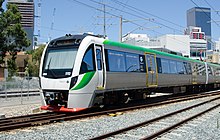Railways in Perth, the capital city of Western Australia, have existed since 1881, when the Eastern Railway was opened between Fremantle and Guildford. Today, Perth has seven Transperth suburban rail lines and 78 stations.
The Transperth network is owned and operated by the WA Public Transport Authority (PTA) and consists of seven lines: the Airport, Armadale, Fremantle, Mandurah, Midland, Thornlie, and Yanchep lines, plus the Ellenbrook line, which is planned to open on 8 December 2024. Perth's trains had 53.2 million boardings in the 2022–23 financial year, giving the Transperth rail network the third highest patronage out of all of Australia's suburban rail networks.[1] Under construction is the Ellenbrook line and the Thornlie–Cockburn link.
A notable feature of Perth's urban rail network is that a significant portion of it operates in the median of freeways, with dedicated bus-train interchanges and extensive Park & Ride (P&R) facilities provided at certain stations.[2][3] Passengers arrive on feeder buses or use P&R and transfer to trains at train stations. These system design features are a response to Perth's low density.[2][4][5][6][7][8]
Cite error: There are <ref group=lower-alpha> tags or {{efn}} templates on this page, but the references will not show without a {{reflist|group=lower-alpha}} template or {{notelist}} template (see the help page).
- ^ Queensland Rail (20 September 2023). "Queensland Rail Annual and Financial Report FY2022-2023, Page 40" (PDF). Queensland Rail. Retrieved 26 October 2023.
- ^ a b Martinovich, Peter (19 June 2009). "Application of a Commuter Railway to Low Density" (PDF). Bureau of Infrastructure, Transport and Regional Economics. Retrieved 8 October 2023.
- ^ Olaru, Doina; Smith, Brett; Xia, Jianhong (Cecilia); Chen, Chunmei; Lin, Ting (Grace); Ying, Huang; Han, Renlong (15 July 2013). ""Ticket to ride": factors affecting park-and-ride travel in Perth, WA" (PDF). ResearchGate. Curtin University. Archived from the original on 27 December 2023. Retrieved 27 December 2023.
{{cite web}}: CS1 maint: bot: original URL status unknown (link) - ^ Martinovich, Peter (30 April 2006). "Designing for Mass Transit Railways in Freeway Medians". Railway Knowledge Bank. Retrieved 8 October 2023.
- ^ Martinovich, Peter (21 July 1992). "Northern Suburbs Transit System: Background and Technical Aspects Considered in the Planning and Design of the Rail Spine". Rail Knowledge Bank. Retrieved 8 October 2023.
- ^ Martinovich, Peter (10–13 November 2002). "The Perth Urban Rail Development Project". Rail Knowledge Bank. Retrieved 25 October 2023.
- ^ Martinovich, Peter (31 October 2007). "The Challenges of Expanding Perth's Rail System (AUSRAIL PLUS 2007)". Railway Knowledge Bank. Retrieved 26 October 2023.
- ^ Laird, Phillip (2016). "Perth's Urban Rail Renaissance". University of Wollongong Research Online. Canberra, Australia: Australian Railway Association. pp. 1–8. Retrieved 21 December 2023 – via AusRAIL PLUS Proceedings 2016, Rail – Moving the Economy Forward.
